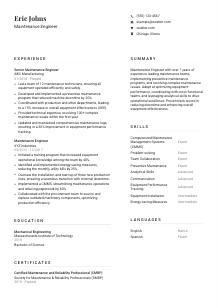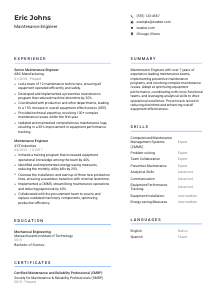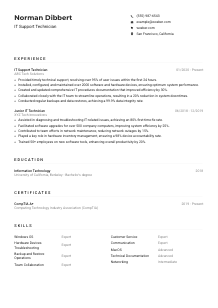Maintenance Engineer CV Example
Fine-tuning machinery, but your CV feels rusty? Oil up your credentials with this Maintenance Engineer CV example, curated using Wozber free CV builder. Discover how to blend your mechanical mastery with job prerequisites, ensuring your career path stays as well-maintained as the systems you oversee!

How to write a Maintenance Engineer CV?
Hello, aspiring Maintenance Engineer! In the realm of machinery and technology, your CV is the critical component that drives your career forward. This is your blueprint to constructing a CV that not only meets but surpasses the expectations of hiring managers. With the Wozber free CV builder at your disposal, we're here to guide you through each gear and piston of creating a CV tailored for the Maintenance Engineer role.
It's time to engineer your success. Let's charge full steam ahead!
Personal Details
Think of the Personal Details section as your blueprint, providing a clear layout of who you are to potential employers. Let's refine this section to ensure your mechanical finesse is evident right from the start.
1. Clear Identification
Your name is the headline of this blueprint. Make it bold and ensure it's the most noticeable part by using a clear, ATS-friendly font. This is where your personal brand gets its first inspection.
2. Position Alignment
Immediately below your name, state your ambition: Maintenance Engineer. Aligning with the job title signals to ATS and hiring managers that your CV is crafted specifically for the role, otimizing your first layer of ATS optimisation.
3. Essential Coordinates
Ensure your contact information (phone number and email) is updated and error-free. For the email, a simple format like firstname.lastname@email.com looks professional and avoids any glitches in the ATS.
4. Location Sync
"Chicago, Illinois" isn't just a location; it's a compliance check with the job description. By specifying this, you're effectively reducing any relocation concerns from the hiring manager's mind.
5. Digital Footprint
Linking your LinkedIn profile (make sure it's polished and mirrors your CV) can add a layer of profundity to your application, making you more than just a piece of paper.
Takeaway
With your Personal Details section engineered like a well-oiled machine, your chances of making a lasting first impression have significantly increased. These details are more than just formalities; they're key coordinates directing the hiring manager to you.





Experience
Your Experience section is the powerhouse of your CV, demonstrating the cogwheels of your career. Let's ensure it showcases your skills as a Maintenance Engineer, offering a clear glimpse into your professional mechanics.
- Led a team of 12 maintenance technicians, ensuring all equipment operated efficiently and safely.
- Developed and implemented a preventive maintenance program that reduced machine downtime by 20%.
- Coordinated with production and other departments, leading to a 15% increase in overall equipment effectiveness (OEE).
- Provided technical expertise, resolving 100+ complex maintenance issues within the first year.
- Updated and maintained comprehensive maintenance logs, resulting in a 30% improvement in equipment performance tracking.
- Initiated a training program that increased equipment operational knowledge among the team by 40%.
- Identified and implemented energy‑saving measures, reducing the monthly utility bills by 25%.
- Oversaw the installation and start‑up of three new production lines, ensuring a seamless transition with minimal downtime.
- Implemented a CMMS, streamlining maintenance operations and reducing paperwork by 60%.
- Collaborated with the procurement team to source and replace outdated machinery components, otimizing production efficiency.
1. Job Breakdown
Start by dissecting the job requirements. For instance, "Developed and implemented a preventive maintenance program" directly reflects a key responsibility. Highlighting similar accomplishments sets the gears in motion for ATS optimisation.
2. Chronological Gear
Organize your professional journey starting with the most recent position. It's like showing the latest model of your engineering prowess, with subsequent models revealing the evolution of your expertise.
3. Accomplishment Pistons
Instead of listing duties, pump your CV with achievements. Mention how you "reduced machine downtime by 20%" to show the tangible outcomes of your engineering interventions.
4. Measurable Impact
Quantify your achievements wherever possible. Numbers are the universal language of engineers, slashing through ambiguity and showcasing your contribution in precise terms.
5. Relevance Filter
Ensure every entry in this section is directly relevant to being a Maintenance Engineer. Unrelated accomplishments, while impressive, may cloud the focus of your CV.
Takeaway
By fine-tuning your experience section, you've demonstrated not just your suitability but your capacity to excel as a Maintenance Engineer. Remember, specificity is the fuel that powers the engine of your CV.
Education
The Education section of your CV lays the foundation of your professional edifice. It's essential to ensure this section is constructed with the same precision as the rest. Let's ensure it's architecturally sound.
1. Core Requirement
Echo the exact degree specified in the job posting. For instance, if it states "Bachelor's degree in Mechanical, Electrical, or Industrial Engineering," listing your "Bachelor of Science in Mechanical Engineering" aligns perfectly.
2. Clear Assembly
This section should be as clear as the schematics of a well-designed machine. List your degree, the institute, and your year of graduation in a clean, uncomplicated manner.
3. Specification Matching
If the job specifically demands expertise in a sector of engineering that matches your education, make sure this is evident. It's like highlighting your machine's best features on the spec sheet.
4. Supplementary Modules
Though the broad strokes of your degree are most important, don't hesitate to mention any particularly relevant courses or projects. Think of these as the added features that make your machine more marketable.
5. Achievement Showcase
If there are accomplishments or extracurricular engagements that showcase your passion and involvement in your field, list them. These paint a picture of a well-rounded and engaged professional.
Takeaway
With your education section meticulously structured, your CV now stands on a rock-solid foundation, proving your credentials are in perfect alignment with your profession's demands.
Certificates
In the world of Maintenance Engineering, certifications can sharpen your competitive edge. Let's explore how to highlight your certifications in a way that polishes your professional profile.
1. Relevance Reconnaissance
Though not explicitly required for our Maintenance Engineer position, certificates like "Certified Maintenance and Reliability Professional (CMRP)" showcase continued learning and mastery in the field.
2. Targeted Selection
Focus on certifications that directly enhance your candidacy for the role. It's like selecting the right tool for the job – efficiency and precision are key.
3. Date Display
Mentioning the validity or acquisition date of your certificates, much like maintenance schedules, offers evidence of your up-to-date expertise and commitment to current standards.
4. Continuous Improvement
Maintenance Engineering, like all fields of engineering, is continually evolving. Regularly updating and acquiring new certificates indicates that you're keeping pace with the industry.
Takeaway
By carefully selecting and displaying your certifications, you add valuable tools to your professional toolbox, each demonstrating specialized knowledge and a commitment to excellence in your field.
Skills
Your Skills section is a compact display of your professional toolkit. For a Maintenance Engineer, it's crucial to highlight skills that demonstrate both your mechanical savvy and your strategic acumen.
1. Spec Sheet Analysis
Harvest key skills directly from the job description, such as "Proficiency in using Computerized Maintenance Management Systems (CMMS)" and match them with your own expertise.
2. Essential Tools Listing
Prioritize hard skills relevant to Maintenance Engineering like CMMS, along with soft skills like team collaboration and communication, balancing your toolkit for the role's demands.
3. Organized Layout
Much like organizing a tool chest for efficiency, categorize and list your skills in a neat, readable format. This not only captivates the hiring manager's attention but also passes the ATS scan with flying colors.
Takeaway
By strategically selecting and arranging your skills, you've ensured your professional toolkit is not only comprehensive but also tailored to impress in the Maintenance Engineering landscape.
Languages
In a multi-faceted world, the ability to communicate across linguistic barriers can amplify your value as a Maintenance Engineer, especially in global companies or diversified teams.
1. Job Language Requirements
For the Maintenance Engineer role, fluency in English was a prerequisite. Positioning your language proficiency at the top showcases your ability to meet this fundamental requirement.
2. Primary Language Highlight
State your proficiency clearly. For instance, if English is your native tongue, notate it as "English: Native." This assures clarity and leaves no room for misinterpretation.
3. Additional Languages
Listing other languages you're familiar with, even at a basic level, can be an asset. It showcases your ability to potentially communicate with broader teams or understand additional documentation.
4. Proficiency Clarity
Be precise about your language proficiency levels. Whether it's "Fluent" in Spanish or "Intermediate" in French, each level offers insight into your capacity for communication.
5. Role Scope Consideration
For roles potentially involving international collaboration, presenting your multilingual abilities can significantly bolster your CV, making you a versatile candidate.
Takeaway
Your linguistic capabilities are a testament to your readiness for a global professional arena, equipping you not just to perform but to collaborate and lead in diverse environments.
Summary
The Summary section is where your personal and professional narrative comes together, revving up interest and compelling hiring managers to take a closer look at the rest of your CV.
1. Role Comprehension
Begin with an understanding of what makes a superb Maintenance Engineer. Reflect on the job description and align your summary to match that profile.
2. Professional Introduction
Lead with a statement that encapsulates your professional identity: "Maintenance Engineer with over 7 years of experience." This sets the stage for your narrative.
3. Highlight Reel
Curate a compact showcase of your career highlights that directly respond to the job's needs, such as reducing downtime and improving machinery efficiency.
4. Brevity and Punch
Keep your summary concise yet powerful. Aim for a handful of sentences that capture the essence of your professional journey, much like a well-crafted executive summary in a report.
Takeaway
With a compelling summary, you've effectively turned the key in the ignition of your CV. This powerful introduction paves the way for the reader to dive deeper into your professional chronicle.
Launching Your Maintenance Engineer Journey
Bravo for meticulously assembling your Maintenance Engineer CV. With Wozber's free CV builder, ATS-friendly CV template, and dedicated ATS CV scanner, you're now equipped to carve out a distinct position in the competitive job market. Your CV, now a polished representation of your expertise and achievements, is ready to open industry doors for you. The career opportunities are vast, and your potential is limitless. Let this be the catalyst for your professional ascent. Go forth and engineer your success!

- Bachelor's degree in Mechanical, Electrical, or Industrial Engineering.
- Minimum of 5 years of experience in maintenance or related engineering field.
- Proficiency in using Computerized Maintenance Management Systems (CMMS).
- Strong analytical and problem-solving skills.
- Excellent communication and team collaboration abilities.
- Must be able to articulate well in English.
- Must be located in or willing to relocate to Chicago, Illinois.
- Lead and supervise the maintenance team to ensure all equipment and systems are operating efficiently and safely.
- Develop and implement preventive maintenance programs for all machinery and equipment.
- Coordinate with production and other departments to minimize downtime and ensure optimal production levels.
- Provide technical expertise to troubleshoot and resolve complex maintenance issues.
- Regularly update maintenance logs, reports, and perform cost analyses for equipment repairs and replacements.















